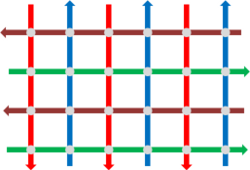本文主要是介绍CF:374A - Inna and Pink Pony(思想题),希望对大家解决编程问题提供一定的参考价值,需要的开发者们随着小编来一起学习吧!
Dima and Inna are doing so great! At the moment, Inna is sitting on the magic lawn playing with a pink pony. Dima wanted to play too. He brought an n × m chessboard, a very tasty candy and two numbers a and b.
Dima put the chessboard in front of Inna and placed the candy in position (i, j) on the board. The boy said he would give the candy if it reaches one of the corner cells of the board. He's got one more condition. There can only be actions of the following types:
- move the candy from position (x, y) on the board to position (x - a, y - b);
- move the candy from position (x, y) on the board to position (x + a, y - b);
- move the candy from position (x, y) on the board to position (x - a, y + b);
- move the candy from position (x, y) on the board to position (x + a, y + b).
Naturally, Dima doesn't allow to move the candy beyond the chessboard borders.
Inna and the pony started shifting the candy around the board. They wonder what is the minimum number of allowed actions that they need to perform to move the candy from the initial position (i, j) to one of the chessboard corners. Help them cope with the task!
The first line of the input contains six integers n, m, i, j, a, b (1 ≤ n, m ≤ 106; 1 ≤ i ≤ n; 1 ≤ j ≤ m; 1 ≤ a, b ≤ 106).
You can assume that the chessboard rows are numbered from 1 to n from top to bottom and the columns are numbered from 1 to m from left to right. Position (i, j) in the statement is a chessboard cell on the intersection of the i-th row and the j-th column. You can consider that the corners are: (1, m), (n, 1), (n, m), (1, 1).
In a single line print a single integer — the minimum number of moves needed to get the candy.
If Inna and the pony cannot get the candy playing by Dima's rules, print on a single line "Poor Inna and pony!" without the quotes.
5 7 1 3 2 2
2
5 5 2 3 1 1
Poor Inna and pony!
Note to sample 1:
Inna and the pony can move the candy to position (1 + 2, 3 + 2) = (3, 5), from there they can move it to positions (3 - 2, 5 + 2) = (1, 7) and (3 + 2, 5 + 2) = (5, 7). These positions correspond to the corner squares of the chess board. Thus, the answer to the test sample equals two.
思路:唉 昨天做题的时候想成了BFS,然后直接T了,确实,数据都达到10^6了,不BFS不T才怪呢……实在是不该啊……刚才又想了一下,唉……真是思想题……
输入n,m,i,j,a,b。有图去考虑的话就知道是思想题了。因为如果那点左上方、右下方、右上方、左下方其与边界横坐标、纵坐标的距离如果都可以整除a,b的话,那说明这肯定可以达到其边界的其中一个顶点的……唉,这想想就简单了好多……可能是上周因为专攻BFS,所以就一直想用BFS,怎么都不想了,结果T了之后,才明白不能乱来啊,还以为这次比赛很难呢,其实是自己练得太少了。思想题真得多练练了……
#include<iostream>
#include<cstdio>
#include<algorithm>
#include<cstring>
#include<string>
#include<cmath>
#include<set>
#include<map>
#include<queue>
#include<vector>
#include<stack>
#include<ctime>
#include<cstdlib>
#define mem(a,b) memset(a,b,sizeof(a))
#define M 1000005
typedef long long ll;
using namespace std;
int n,m,i,j,a,b,ans=1<<30;
int abc(int x,int y)
{int x1=x%a;int y1=y%b; if(!x1&&!y1) //如果都整除{int p=abs(x/a-y/b); //并且其次数之差为偶数才行if(!(p&1)) return min(max(x/a,y/b),ans); //因为次数不相等的话,那大的那个得先变为与次数小的一样才行,变的过程借助a或者b,故偶数时才得正常转化}return ans;
}
int main()
{cin>>n>>m>>i>>j>>a>>b;if(i==1&&j==1||i==n&&j==1||i==1&&j==m||i==n&&j==m)printf("0\n");else{if(i-1>0&&j-1>0) ans=abc(i-1,j-1);if(i-1>0&&m-j>0) ans=abc(i-1,m-j); //如果不在边界正常判断,调用判断函数if(n-i>0&&j-1>0) ans=abc(n-i,j-1);if(n-i>0&&m-j>0) ans=abc(n-i,m-j);if((i+a<=n&&i==1&&!((j-1)%b)||n-a>0&&i==n&&!((j-1)%b))&&((j-1)/b)%2==0) ans=min((j-1)/b,ans); //如果在边界可以直接判断,符合的话,次数会更少if((i+a<=n&&i==1&&!((m-j)%b)||n-a>0&&i==n&&!((m-j)%b))&&((m-j)/b)%2==0) ans=min((m-j)/b,ans); //但是在边界因为要借助a或者bif((j+b<=m&&j==1&&!((i-1)%a)||m-b>0&&j==m&&!((i-1)%a))&&((i-1)/a)%2==0) ans=min((i-1)/a,ans); //所以需要判断i+a,n-i,j+b,m-j不能超过边界if((j+b<=m&&j==1&&!((n-i)%a)||m-b>0&&j==m&&!((n-i)%a))&&((n-i)/a)%2==0) ans=min((n-i)/a,ans);if(ans==(1<<30)) printf("Poor Inna and pony!\n");else printf("%d\n",ans);}return 0;
}
下面是比赛的时候写的BFS解法:超时了,哈哈#include<iostream>
#include<cstdio>
#include<algorithm>
#include<cstring>
#include<string>
#include<cmath>
#include<set>
#include<map>
#include<queue>
#include<vector>
#include<stack>
#include<ctime>
#include<cstdlib>
#define mem(a,b) memset(a,b,sizeof(a))
#define M 1000005
typedef long long ll;
using namespace std;
int n,m,i,j,a,b;
struct abc
{ int x,y,t;
};
queue<abc>q;
multimap<int,int>w;
multimap<int,int>::iterator it;
int bfs()
{ abc p; p.x=i; p.y=j; p.t=0; q.push(p); while(!q.empty()) { abc ans,tem; ans=q.front(); q.pop(); if(ans.x==1&&ans.y==m||ans.x==1&&ans.y==1||ans.x==n&&ans.y==1||ans.x==n&&ans.y==m) return ans.t; int a1,b1; for(int i=0; i<4; i++) { if(i==0) { a1=-a; b1=-b; } else if(i==1) { a1=-a; b1=b; } else if(i==2) { a1=a; b1=-b; } else { a1=a; b1=b; } tem.x=ans.x+a1; tem.y=ans.y+b1; if(tem.x>=1&&tem.y>=1&&tem.x<=n&&tem.y<=m) { it=w.find(tem.x); if(it==w.end()||it->second!=tem.y) { tem.t=ans.t+1; q.push(tem); pair<int,int> p1(tem.x,tem.y); w.insert(p1); } } if(tem.x==1&&tem.y==m||tem.x==1&&tem.y==1||tem.x==n&&tem.y==1||tem.x==n&&tem.y==m) return tem.t; } } return -1;
}
int main()
{ cin>>n>>m>>i>>j>>a>>b; int sum=bfs(); if(sum==-1) printf("Poor Inna and pony!\n"); else printf("%d\n",sum); return 0;
} 这篇关于CF:374A - Inna and Pink Pony(思想题)的文章就介绍到这儿,希望我们推荐的文章对编程师们有所帮助!



